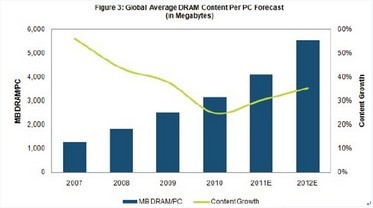 According to IHS iSuppli’s memory and storage reports, the rate of growth of DRAM content in personal computers (PCs) will historically decline, and the average annual growth rate of DRAM content in each new PC after 2012 will not exceed 35%. Below the average of 48% in the last 25 years.
According to IHS iSuppli’s memory and storage reports, the rate of growth of DRAM content in personal computers (PCs) will historically decline, and the average annual growth rate of DRAM content in each new PC after 2012 will not exceed 35%. Below the average of 48% in the last 25 years. Following an increase of 38% and 25% respectively in 2009 and 2010, the average DRAM content per PC in 2011 and 2012 will increase by 30% and 35%, respectively, as shown in Figure 3. However, the growth rate in 2012 will reach a high point, and the growth rate in the following years is expected to be significantly lower than 35%. In contrast, the compound annual growth rate of 1985-2009 was 48%, and the growth rate in the first few years of the 21st century was as high as 40-45%.
As DRAM content growth slows, memory vendors will have to look beyond the PC for growth, such as smartphones and tablets. Although new products will surely bring more demand, memory will no longer be able to count on its long-dependent PC industry.
The growth rate of DRAM content in operating system slimming PCs has gradually slowed down. One of the reasons is that the newly introduced operating systems tend to be miniaturized.
In the past, every time Microsoft introduced a new version of the Windows operating system, it usually required more computing resources and memory. For example, after the introduction of Windows 95, Windows 98, and Windows Vista, the required DRAM content increased significantly. Although the required DRAM content did not increase sharply during the launch of Windows XP in 2011, DRAM content increased in the two years after its launch.
However, Windows 7 broke the above trend and its DRAM content requirements are the same as those of Windows Vista. From the release of Windows 7 in 2009 to a year later, the growth rate of DRAM content in each PC has dropped by 13%, indicating that the growth rate will be lower in the coming years.
It now appears that the Windows 8 operating system, scheduled to be launched in the second half of 2012, will maintain the trend created by Windows 7. Microsoft has made it clear that Windows 8 hardware requirements will not exceed Windows 7, including hardware related to DRAM and storage.
Other factors driving memory growth Although new operating systems no longer necessarily lead to increased hardware requirements, PC users will need to use operating systems to perform operations such as starting multiple simultaneous applications and playing video files that require more memory. Memory. IHS believes that as consumer demand for digital content continues to expand, memory requirements will increase.
And while the operating system is no longer the main driver of memory growth, the pursuit of more tasks in less time will not disappear.
Fenghua Jade Motor Co., Ltd. , http://www.nscircuitbreaker.com